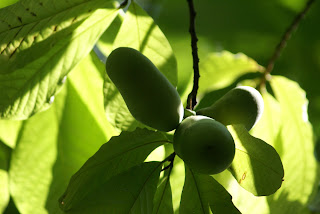
Paw paws are the northern representative of what is a huge tropical family of trees, including the tropical custard apple, which my old economic botany text book calls "the queen of tropical fruits".

Paw paws are loaded with aromatics; crush a leaf and you smell green peppers. Cut open a ripe fruit and you get a whiff of sweet potato and banana. The taste is the same; sounds kind of ghastly, but is surprisingly good on the pallate. Just make sure the fruit is fully ripe - green ones can be mouth puckeringly astringent. Paw paw leaves are the only food plant for caterpillars of the zebra swallowtail butterfly, and the Potomac valley is well known among lepidopterists as the best place to see this hauntingly beautiful species.

The late Euell Gibons, in his Stalking the Wild Asparagus, gives a recipe for paw paw chiffon pie, although you would be hard put to find enough ripe fruits to give it a try; I only found enough unchewed fruit to fill a baseball cap. Everything in the woods, from bears to mice, eats paw paws. Paw paw seeds are the size of nickels, and as hard and brown as mahogany. They are designed to be gulped down with the sweet pulp and (ahem) deposited some distance away from the parent tree. Dan Janzen, an ecologist at the University of Pennsylvania writes that these fruits, along with those of persimmon, honey locust, and others, were originally dispersed by Ice Age megafauna such as mastodons and giant sloths (or as those in the business call them, BHMs - Big Hairy Mammals). If that is true, when you enjoy a ripe paw paw, fresh off the forest floor, you are fulfilling a role once played by extinct beasts. Just remember to swallow and do like the bears do.
No comments:
Post a Comment